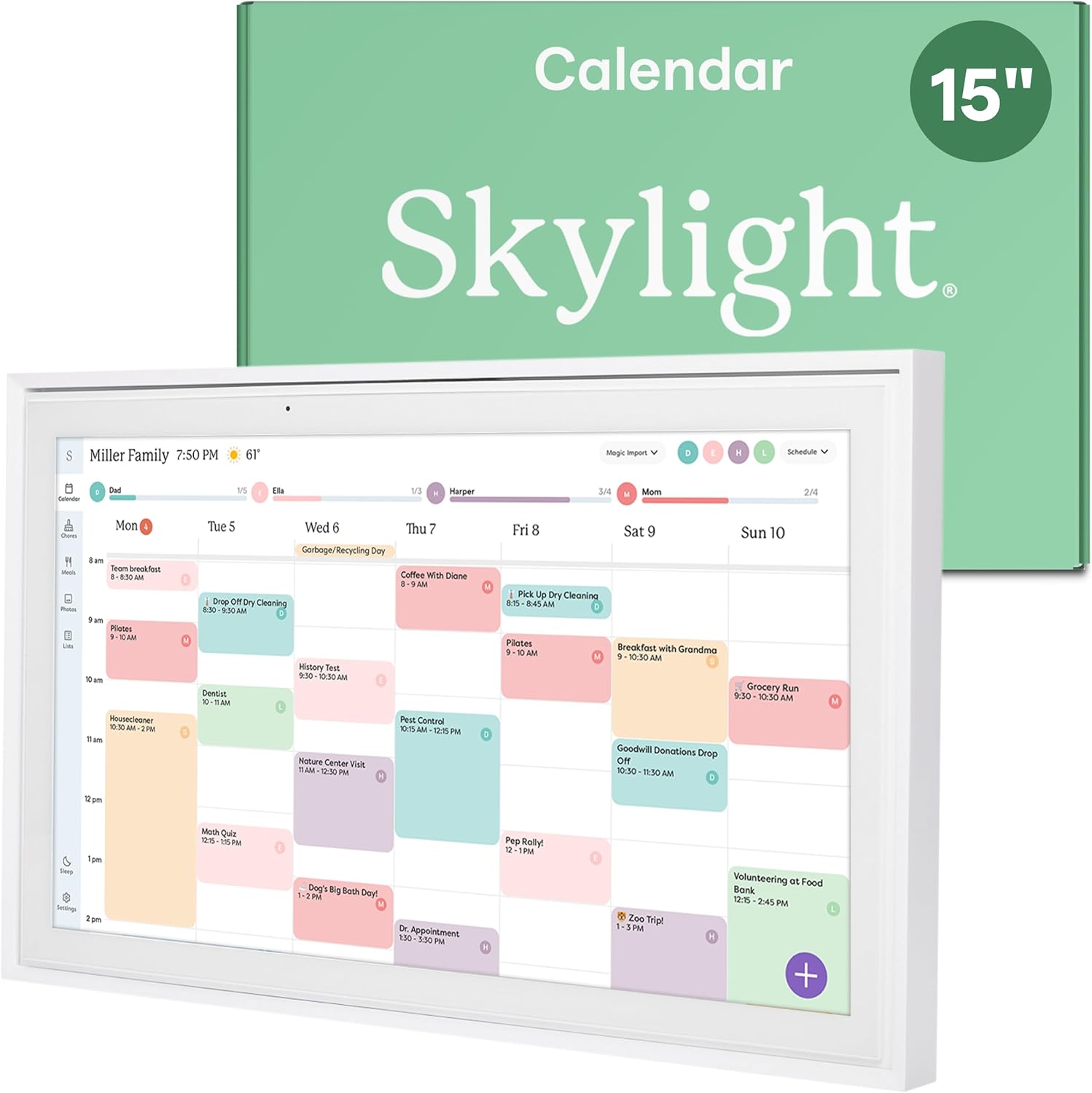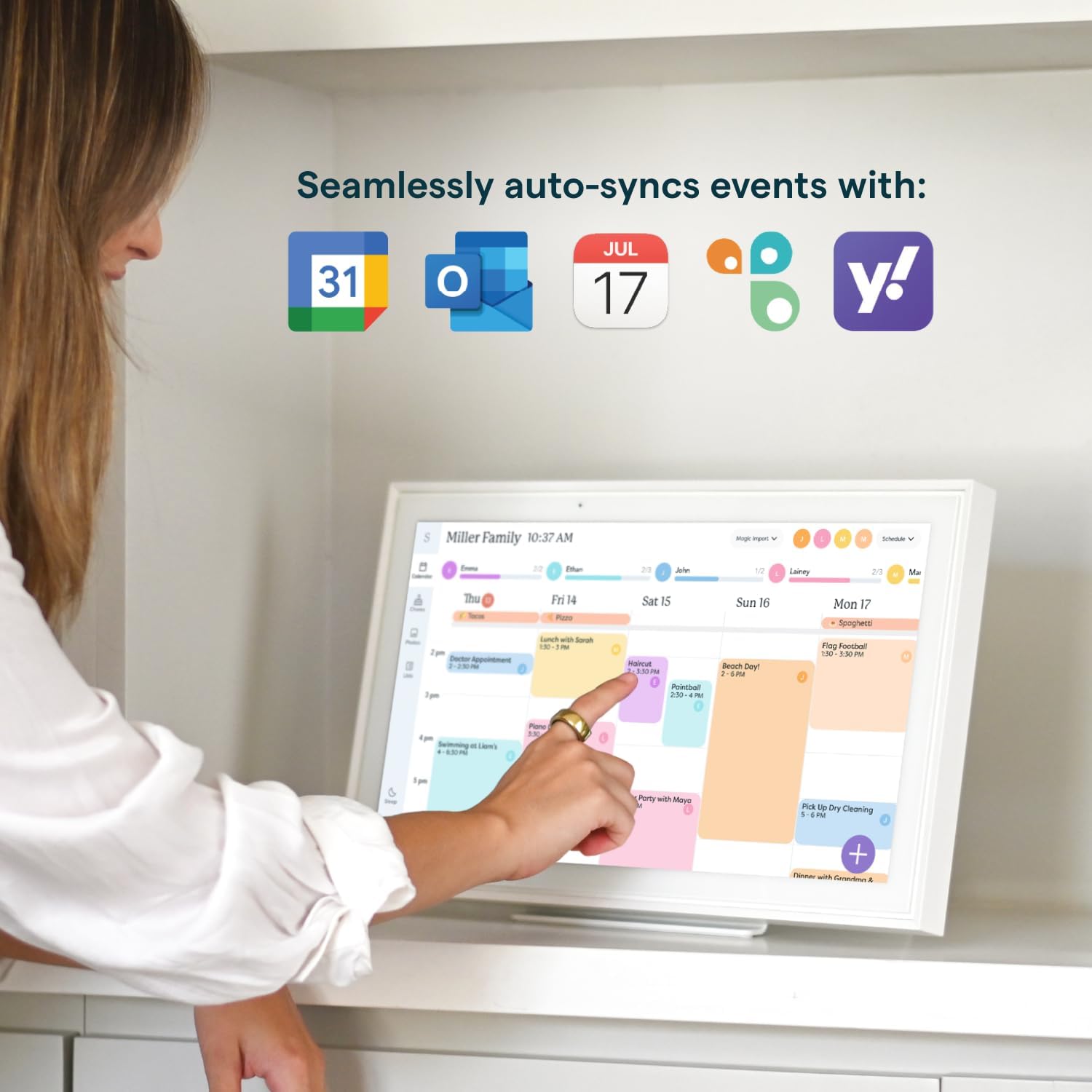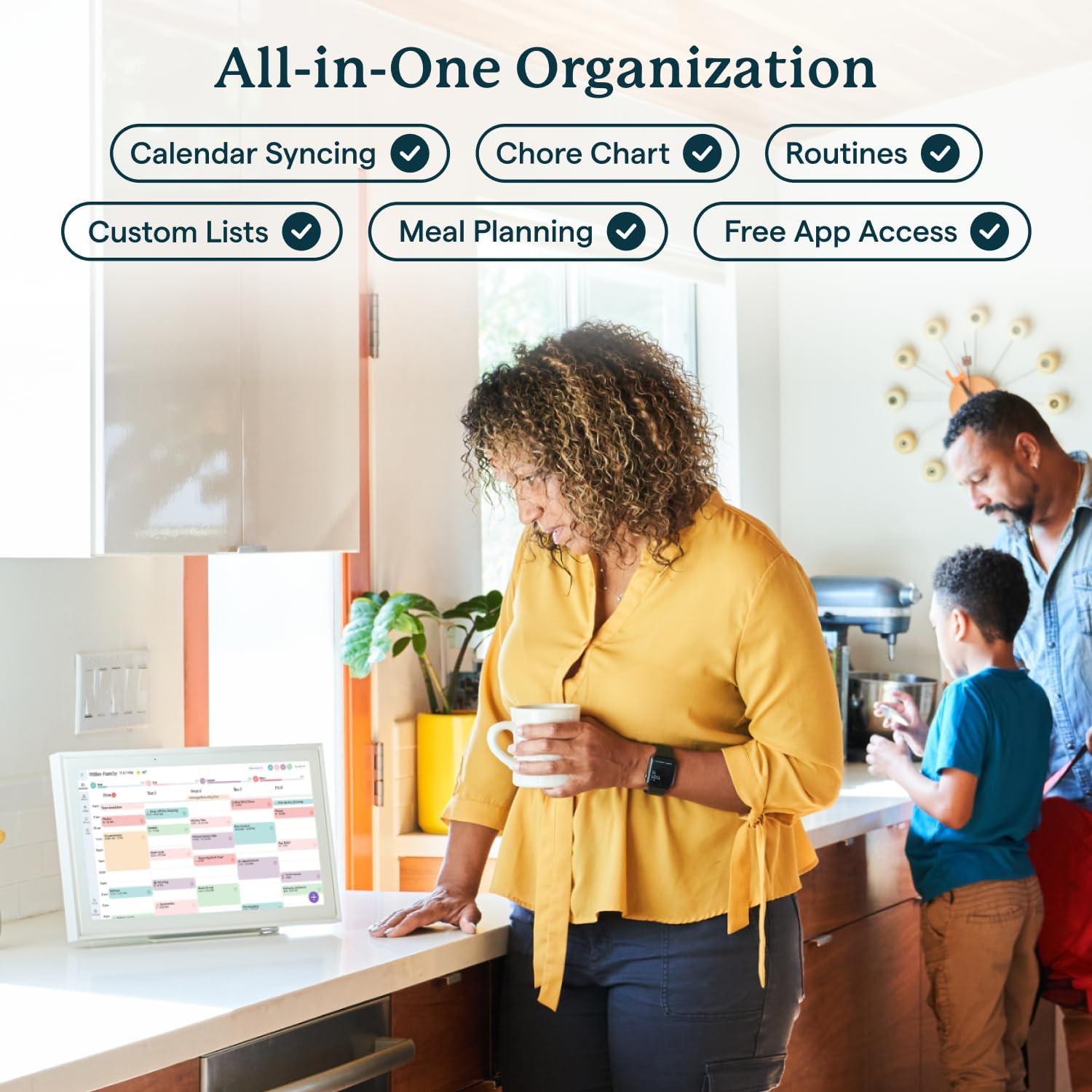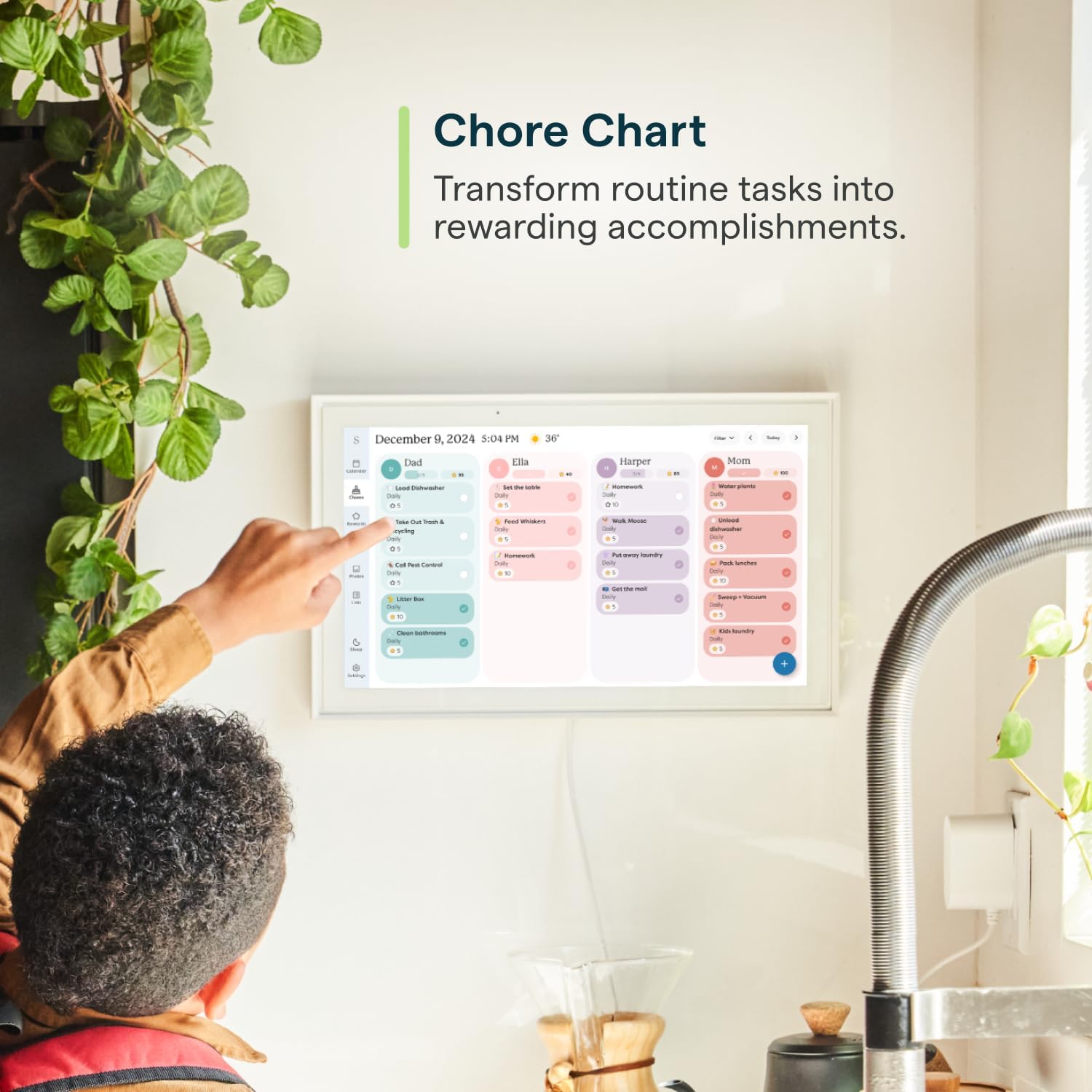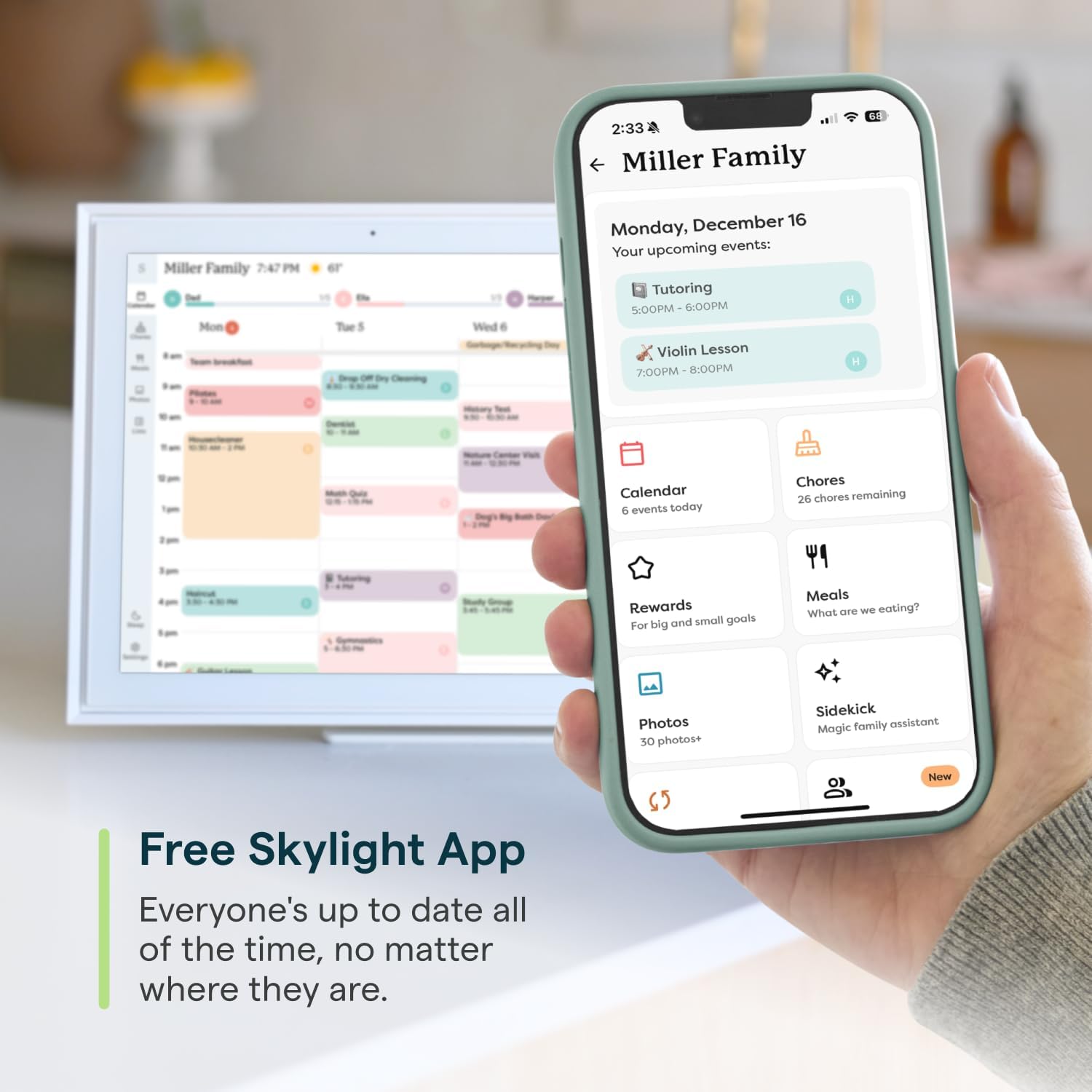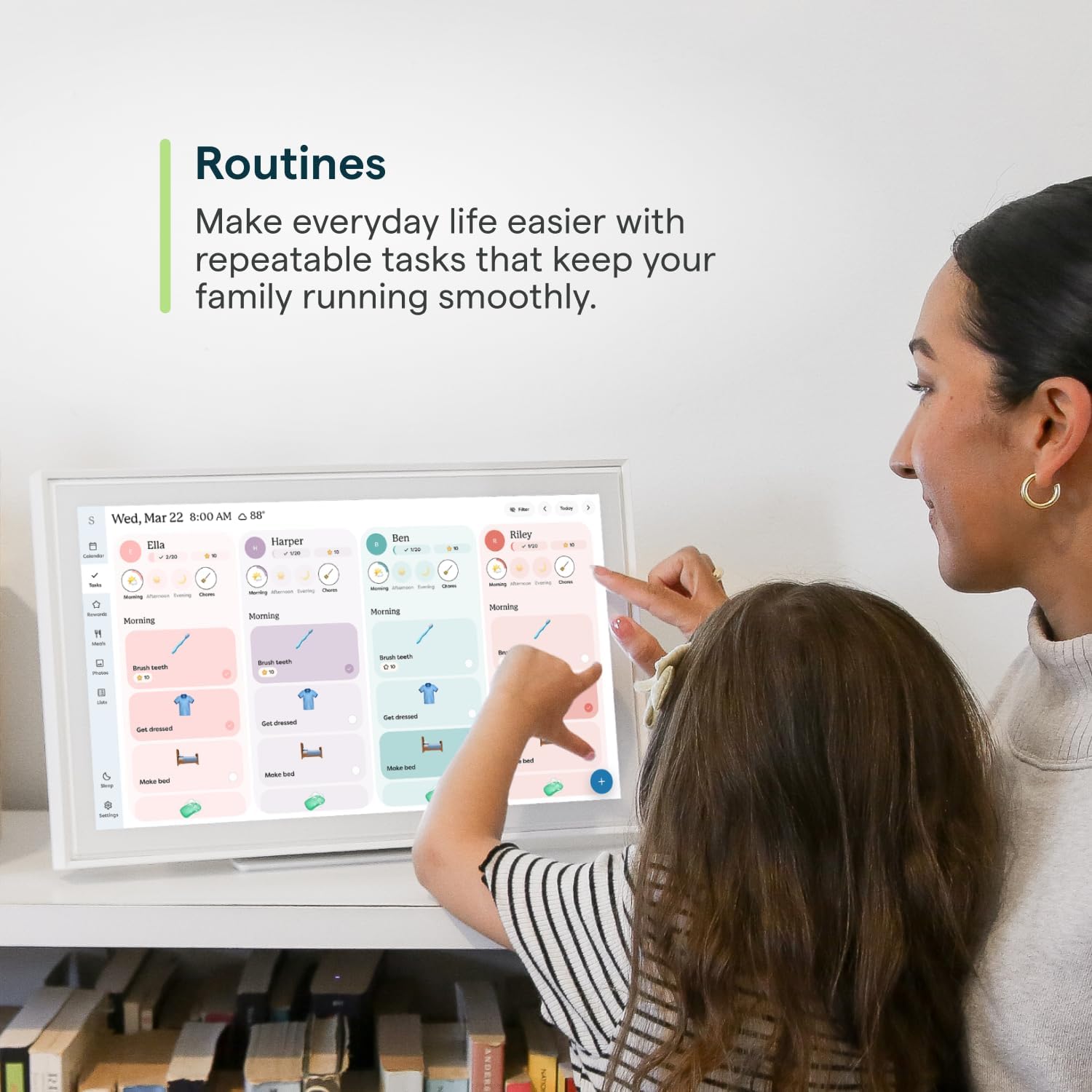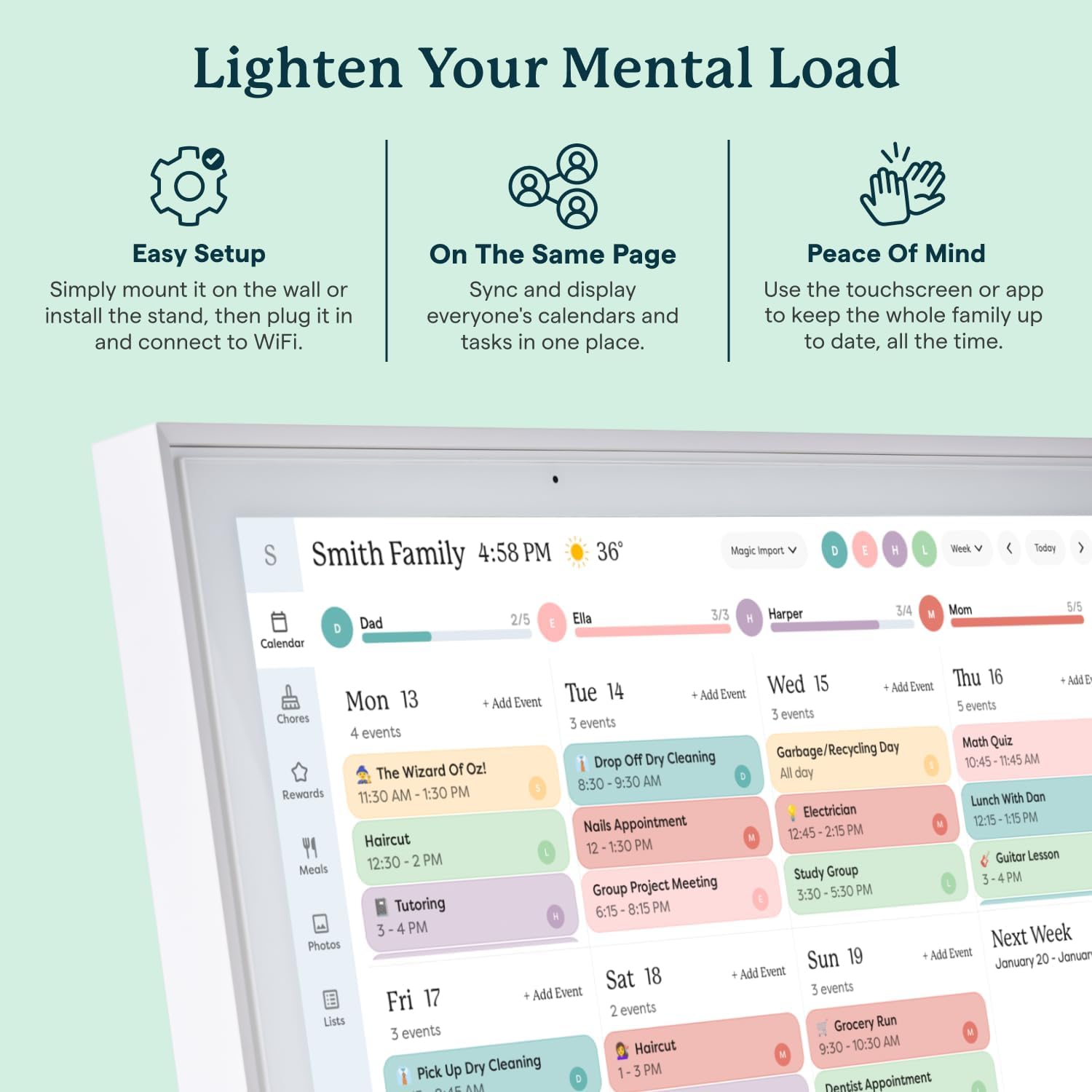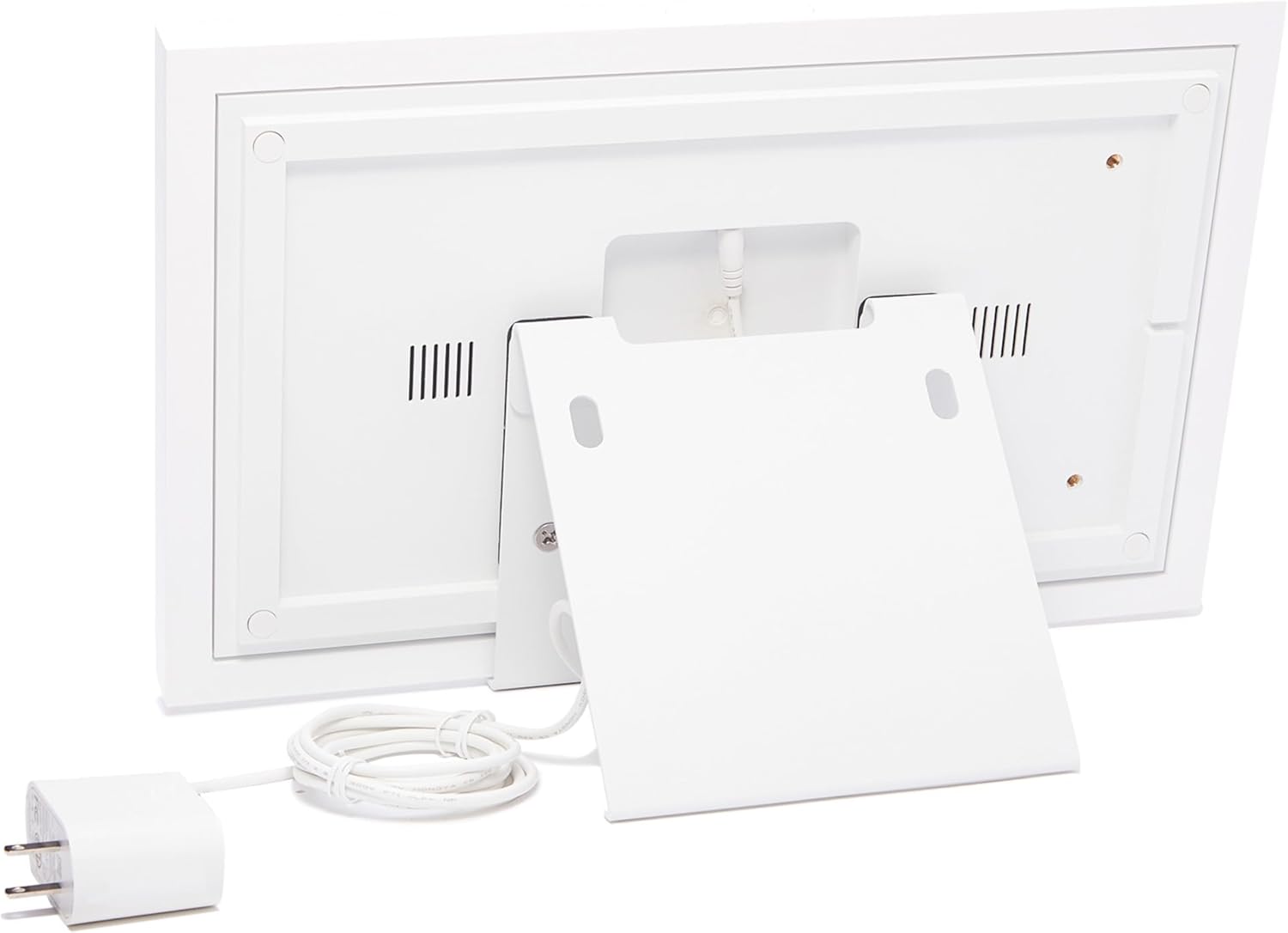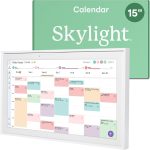
Skylight Calendar: 15-inch Wall Planner Review skylight calendar – Oemiu
Skylight Calendar: A Deep Dive into the 15-Inch Smart Wall Planner
In today’s relentlessly connected world, staying organized as a family or team can feel like a monumental task. Juggling appointments, reminders, and shared events often leads to missed deadlines and unnecessary stress. Traditional paper calendars, while reliable, lack the dynamic nature required to keep pace with our fast-moving lives. Enter the Skylight Calendar, a 15-inch smart wall planner designed to seamlessly integrate into your home or office and streamline scheduling. But does this digital calendar truly deliver on its promise of enhanced organization and connectivity? This in-depth review will explore the Skylight Calendar’s features, benefits, and potential drawbacks to help you decide if it’s the right solution for your needs.
Unboxing and First Impressions: Setting the Stage for Smarter Scheduling
The Skylight Calendar arrives well-packaged, reflecting the company’s attention to detail and commitment to a premium user experience. The box contains the 15-inch Skylight Calendar itself, an AC power adapter, and a quick start guide. The device boasts a clean, minimalist design that blends effortlessly with various interior styles. The large, high-resolution display is immediately striking, promising excellent readability from across the room. The touch screen is responsive and intuitive, making navigation a breeze. Setting up the Skylight Calendar is surprisingly straightforward. The initial configuration involves connecting to your Wi-Fi network and creating a Skylight account. Once connected, you can begin adding family members or team members and syncing your existing Google, Outlook, Apple, and Cozi calendars. This initial syncing process is crucial for establishing a unified view of everyone’s schedules, a core strength of the Skylight Calendar. The user interface is clean and uncluttered, avoiding the overwhelming complexity often associated with digital calendars. Icons are clear and easily understandable, making it accessible for users of all technical abilities. The ability to customize the display with family photos adds a personal touch, transforming the device from a mere organizational tool into a cherished family centerpiece. The large screen real estate provides ample space for viewing appointments, tasks, and reminders without feeling cramped or overwhelming. This is a significant advantage over smaller digital calendars or smartphone screens, particularly for those with visual impairments or those who simply prefer a larger, more easily readable display. The Skylight Calendar aims to be more than just a calendar; it aims to be a central hub for family or team communication and coordination. Its initial design and easy setup definitely set the stage for achieving that goal. Keeping family organization simple is what a lot of people are looking for, and the Skylight Calendar is a promising contender.
Key Features and Functionality: Exploring the Power of the Smart Wall Planner
The Skylight Calendar is packed with features designed to simplify scheduling and enhance communication. At its core, it offers seamless synchronization with popular calendar platforms like Google Calendar, Outlook Calendar, Apple Calendar, and Cozi. This eliminates the need for manual entry of events and ensures that everyone is always on the same page. The device supports multiple user accounts, allowing each family member or team member to have their own personalized view of the calendar. Color-coding options make it easy to differentiate between individual schedules and shared events. Beyond basic calendar functionality, the Skylight Calendar offers robust task management capabilities. Users can create and assign tasks, set deadlines, and track progress, making it an ideal tool for managing household chores or team projects. The integrated photo sharing feature allows users to send photos directly to the calendar from their smartphones, creating a shared family photo album that is constantly updated. This adds a personal touch and transforms the device into a living memory board. The Skylight Calendar also supports custom lists, which can be used for creating grocery lists, to-do lists, or any other type of list that you want to share with your family or team. These lists are easily editable and can be accessed from anywhere, making it easy to keep everyone informed and organized. The meal planning feature is another standout, allowing users to plan meals for the week and share the menu with the entire family. This feature can be particularly helpful for families with busy schedules or those who are trying to eat healthier. The ability to set reminders for appointments, tasks, and events is another essential feature. These reminders can be customized to be delivered via email or push notifications, ensuring that you never miss an important deadline. The Skylight Calendar also integrates with voice assistants like Alexa and Google Assistant, allowing you to add events, check your schedule, and manage tasks using voice commands. This hands-free functionality is particularly useful when you’re busy cooking, cleaning, or working on other tasks. The device’s intuitive interface and comprehensive feature set make it a powerful tool for managing your personal and family life. It’s a convenient hub for keeping everyone connected and informed, and its versatility makes it suitable for a wide range of use cases.
Performance and Usability: A Smooth and Intuitive Experience
The Skylight Calendar excels in performance and usability, offering a smooth and intuitive user experience. The touch screen is highly responsive, allowing for effortless navigation and interaction. The device boots up quickly and operates without any noticeable lag or slowdown, even when handling multiple calendar integrations and tasks. The synchronization process with other calendar platforms is seamless and reliable, ensuring that your schedules are always up-to-date. The large display is a major advantage, providing excellent readability from across the room. The high resolution ensures that text and images are sharp and clear, even for those with visual impairments. The user interface is clean and uncluttered, making it easy to find the features you need and navigate through the various options. The intuitive design minimizes the learning curve, allowing users of all technical abilities to quickly master the device. Adding events, tasks, and reminders is a straightforward process. The device offers a variety of input methods, including touch screen, voice commands, and keyboard input. The ability to customize the display with family photos adds a personal touch and enhances the overall user experience. The photo sharing feature is particularly easy to use, allowing you to send photos directly to the calendar from your smartphone with just a few taps. The Skylight Calendar’s performance is consistently reliable, and its user-friendly design makes it a pleasure to use. It’s a device that seamlessly integrates into your daily life, helping you stay organized and connected without adding unnecessary complexity. Even the process of managing the Skylight calendar with Google calendar is simplified, making cross platform management less stressful. The consistent performance and intuitive interface are key factors that contribute to the overall positive user experience. The device is designed to be accessible and easy to use for everyone in the family, regardless of their technical skills. This inclusivity is a significant advantage over more complex digital calendars that may require specialized knowledge or training.
Comparing the Skylight Calendar: Alternatives and Value Proposition
While the Skylight Calendar offers a compelling set of features and benefits, it’s important to consider alternative options and assess its overall value proposition. Several other smart calendar devices are available on the market, each with its own strengths and weaknesses. One popular alternative is the Seller Echo Show, which combines the functionality of a smart speaker with a visual display. The Echo Show can display calendar events, reminders, and tasks, and it also offers voice control through Alexa. However, the Echo Show’s screen is smaller than the Skylight Calendar’s, and its calendar features are not as robust. Another alternative is the Google Nest Hub Max, which also integrates with Google Calendar and offers voice control through Google Assistant. The Nest Hub Max has a slightly larger screen than the Echo Show, but it still falls short of the Skylight Calendar’s 15-inch display. Furthermore, the Nest Hub Max’s focus is more on general smart home control rather than specialized calendar management. Traditional paper calendars remain a viable option for some users, particularly those who prefer a tactile experience. However, paper calendars lack the dynamic nature of digital calendars and require manual updating. They also don’t offer the same level of integration with other devices and services. The Skylight Calendar’s value proposition lies in its large display, comprehensive feature set, and seamless integration with popular calendar platforms. It’s designed specifically for managing family or team schedules and offers a range of features that are not available on other smart devices. While the Skylight Calendar may be more expensive than some of its competitors, its superior performance and user experience justify the investment for those who prioritize organization and connectivity. The Skylight Calendar simplifies the process of sharing a family schedule across different platforms. Here’s a comparison table outlining some key differences:
| Feature | Skylight Calendar | Seller Echo Show 15 | Google Nest Hub Max |
|---|---|---|---|
| Screen Size | 15 inches | 15.6 inches | 10 inches |
| Calendar Integration | Google, Outlook, Apple, Cozi | Google, Outlook | |
| Voice Control | Alexa, Google Assistant (limited) | Alexa | Google Assistant |
| Photo Sharing | Yes | Yes | Yes |
| Task Management | Yes | Limited | Limited |
| Price (approximate) | $159.99 | $249.99 | $229.99 |
Ultimately, the best calendar solution depends on your individual needs and preferences. If you prioritize a large display, comprehensive features, and seamless integration with multiple calendar platforms, the Skylight Calendar is an excellent choice. If you’re looking for a more general-purpose smart home device with basic calendar functionality, the Seller Echo Show or Google Nest Hub Max may be suitable alternatives.
Potential Drawbacks and Considerations: Weighing the Pros and Cons
While the Skylight Calendar offers numerous benefits, it’s important to acknowledge its potential drawbacks and consider whether they outweigh the advantages for your specific situation. One potential concern is the price. The Skylight Calendar is more expensive than some of its competitors, which may be a barrier for budget-conscious consumers. However, it’s important to consider the long-term value of the device and the potential cost savings associated with improved organization and reduced stress. Another potential drawback is the lack of portability. The Skylight Calendar is designed to be wall-mounted and is not easily moved from one location to another. This may be a limitation for users who need a calendar that they can take with them on the go. The device relies on a Wi-Fi connection to function properly. If your Wi-Fi network is unreliable or unavailable, the Skylight Calendar will not be able to sync with your calendars or receive updates. This could be a significant issue for users who live in areas with poor internet connectivity. The Skylight Calendar’s user interface is relatively simple and may not appeal to users who prefer a more feature-rich and customizable experience. While the device offers a range of features, it may not be as flexible or adaptable as some other digital calendars. The reliance on a touch screen could be a drawback for some users, particularly those who prefer physical buttons or a keyboard. While the touch screen is responsive, it may not be as precise or efficient as other input methods. The Skylight Calendar’s privacy policy has also been a subject of concern for some users. While the company claims to protect user data, it’s important to carefully review the privacy policy and understand how your data is being collected and used. Despite these potential drawbacks, the Skylight Calendar remains a compelling option for many users. Its large display, comprehensive feature set, and seamless integration with popular calendar platforms make it a valuable tool for managing family or team schedules. However, it’s important to carefully weigh the pros and cons and consider whether the device is a good fit for your individual needs and preferences. The cost is a considerable factor for some people, but many find that the long-term benefits of the Skylight calendar outweigh the initial investment. The need for a stable Wi-Fi connection is also a critical factor to consider, as the device’s functionality is heavily dependent on internet connectivity.
FAQ
What calendars are compatible with the Skylight Calendar?
The Skylight Calendar boasts wide compatibility with popular calendar platforms, ensuring a seamless integration into your existing digital life. It readily syncs with Google Calendar, Outlook Calendar, Apple Calendar, and Cozi, allowing you to consolidate all your schedules in one centralized location. This eliminates the need for manual data entry and ensures that everyone in your family or team is always on the same page. The ability to connect multiple calendars from different platforms is a significant advantage, especially for households or teams that use a variety of calendaring systems. The syncing process is generally straightforward and reliable, but it’s important to ensure that your calendar settings are properly configured to allow the Skylight Calendar to access your data. You’ll need to grant the Skylight Calendar permission to view and modify your calendars, which may require adjusting your privacy settings on each platform. Once the initial setup is complete, the Skylight Calendar will automatically sync with your calendars on a regular basis, ensuring that your schedules are always up-to-date.
Does the Skylight Calendar require a subscription?
The Skylight Calendar operates on a freemium model. The core calendar functionality, including syncing with existing calendars, creating events, and setting reminders, is available without a subscription. However, Skylight offers a paid subscription plan called Skylight Plus that unlocks additional features and benefits. Skylight Plus includes features like extended photo storage, unlimited photo sending, the ability to create custom lists, and advanced task management tools. The subscription is optional and is not required to use the basic calendar features. However, if you want to take full advantage of the Skylight Calendar’s capabilities, the Skylight Plus subscription may be worth considering. The cost of the Skylight Plus subscription varies depending on the plan you choose, but it’s generally priced competitively with other subscription-based calendar services. Whether or not the Skylight Plus subscription is worth it depends on your individual needs and usage patterns. If you primarily use the Skylight Calendar for basic scheduling and reminders, the free version may be sufficient. However, if you frequently share photos, create lists, or manage tasks, the Skylight Plus subscription could provide significant value.
Can I use the Skylight Calendar without Wi-Fi?
While the Skylight Calendar offers some basic functionality without a Wi-Fi connection, its core features are heavily reliant on internet connectivity. Without Wi-Fi, the Skylight Calendar will not be able to sync with your calendars, receive updates, or access online features like photo sharing and voice control. You will still be able to view existing events and reminders that were previously synced, but you will not be able to add new events or make changes to your schedule until you reconnect to Wi-Fi. The Skylight Calendar is essentially a cloud-based device, meaning that it relies on a connection to the internet to access and update its data. Without Wi-Fi, it functions as a static display of your previously synced calendar information. This limitation is important to consider if you live in an area with unreliable internet connectivity or if you plan to use the Skylight Calendar in a location without Wi-Fi access. In such cases, you may want to consider alternative calendar solutions that do not rely on a constant internet connection. For users who primarily use the Skylight Calendar at home or in the office, the reliance on Wi-Fi is generally not an issue. However, it’s important to be aware of this limitation and ensure that your Wi-Fi network is reliable before investing in the device.
How do I add family members to the Skylight Calendar?
Adding family members to the Skylight Calendar is a straightforward process that allows everyone to stay connected and informed. You can add family members through the Skylight app or directly on the Skylight Calendar device. To add a family member, you will need to enter their email address. The Skylight Calendar will then send them an invitation to join your family group. Once they accept the invitation, they will be able to sync their calendars with the Skylight Calendar and view shared events and reminders. Each family member can have their own personalized view of the calendar, with color-coding options to differentiate between individual schedules and shared events. You can also assign different roles to family members, such as administrator or member. Administrators have full control over the Skylight Calendar settings, while members have limited access. The ability to add multiple family members is a key advantage of the Skylight Calendar, making it a central hub for family communication and coordination. It’s important to ensure that each family member has their own Skylight account and that their calendar settings are properly configured to allow the Skylight Calendar to access their data. This may require adjusting privacy settings on their respective calendar platforms. Once everyone is connected, the Skylight Calendar will automatically sync their schedules, ensuring that everyone is always on the same page.
Can I use the Skylight Calendar for business purposes?
While the Skylight Calendar is primarily marketed as a family organization tool, it can also be effectively used for business purposes, particularly for small teams or departments. Its large display, comprehensive feature set, and seamless integration with popular calendar platforms make it a valuable tool for managing team schedules, tasks, and reminders. The ability to add multiple users and assign different roles allows you to create a collaborative work environment where everyone is kept informed and organized. You can use the Skylight Calendar to schedule meetings, track project deadlines, and assign tasks to team members. The integrated task management feature allows you to create and assign tasks, set deadlines, and track progress. You can also use the Skylight Calendar to share important documents, photos, and announcements with your team. The photo sharing feature can be used to share project updates, team photos, or inspirational quotes. The custom list feature can be used to create to-do lists, project checklists, or contact lists. The Skylight Calendar’s intuitive interface and ease of use make it accessible for users of all technical abilities, which is particularly important in a business setting. However, it’s important to note that the Skylight Calendar is not designed for large enterprises or organizations with complex scheduling needs. It lacks some of the advanced features found in dedicated business calendar software, such as resource scheduling and advanced reporting. For small teams or departments, however, the Skylight Calendar can be a cost-effective and user-friendly solution for managing schedules and improving communication.
How do I troubleshoot common issues with the Skylight Calendar?
Like any electronic device, the Skylight Calendar may occasionally encounter technical issues. Fortunately, most common problems can be easily resolved with a few simple troubleshooting steps. One common issue is a failure to sync with your calendars. If you’re experiencing syncing problems, first ensure that your Wi-Fi connection is stable and that your Skylight Calendar is connected to the internet. Then, verify that your calendar settings are properly configured and that you have granted the Skylight Calendar permission to access your data. You may also need to restart the Skylight Calendar or re-authenticate your calendar accounts. Another common issue is a unresponsive touch screen. If the touch screen is not responding, try cleaning the screen with a soft, dry cloth. You may also need to restart the Skylight Calendar or perform a factory reset. A factory reset will erase all your data and settings, so be sure to back up your information before proceeding. If you’re experiencing other technical issues, such as a blank screen, a frozen display, or error messages, consult the Skylight Calendar’s user manual or online help resources. The Skylight website provides a comprehensive FAQ section and troubleshooting guide that can help you resolve most common problems. You can also contact Skylight’s customer support team for assistance. Their support team is generally responsive and helpful, and they can provide guidance on resolving more complex technical issues. By following these troubleshooting steps, you can often resolve common issues with the Skylight Calendar and keep it running smoothly. If the issue persists despite your best efforts, contact Skylight’s customer support team for further assistance.
What is the return policy for the Skylight Calendar?
Skylight offers a fairly standard return policy, allowing customers to return the Skylight Calendar for a full refund within a specified timeframe. Typically, this period is 30 days from the date of purchase, but it’s always best to double-check the official Skylight website or your purchase confirmation for the most up-to-date information, as policies can change. To be eligible for a return, the device usually needs to be in its original condition, including all packaging and accessories. It’s a good idea to keep the original box and packing materials safe in case you decide to return the Skylight Calendar. The return process generally involves contacting Skylight customer support to initiate the return and obtain a return authorization. You will likely be responsible for paying the return shipping costs. Once Skylight receives the returned device and verifies that it meets the return policy requirements, they will issue a full refund to your original method of payment. It’s important to note that the return policy may vary slightly depending on where you purchased the Skylight Calendar. If you purchased it from a third-party retailer like Seller or Best Buy, their return policies may apply instead. Always review the specific return policy of the retailer from whom you made your purchase. The Skylight Calendar’s return policy provides customers with peace of mind, knowing that they can return the device for a full refund if they are not satisfied with it. This is a valuable consideration when making a purchase, as it allows you to try out the device risk-free and determine whether it’s the right fit for your needs.
